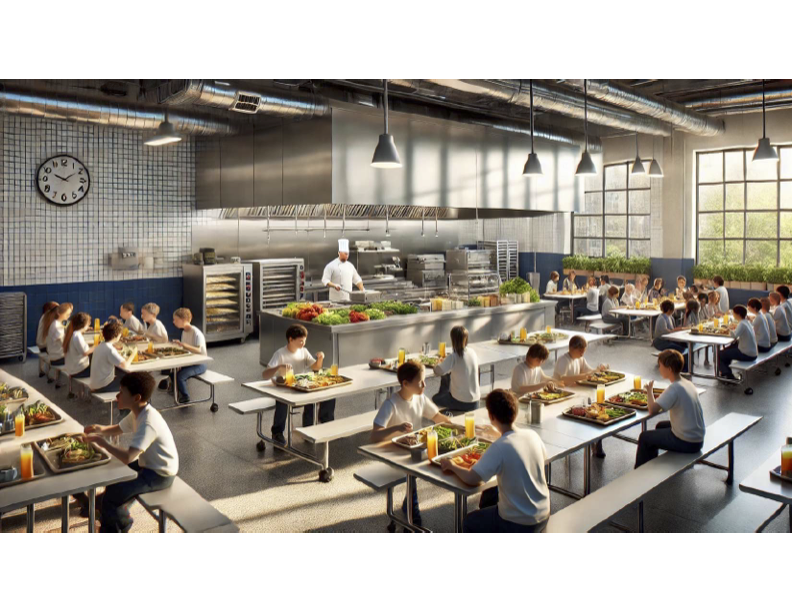A well-designed ventilation system is essential for a school cafeteria to ensure a safe, comfortable, and efficient environment for students, staff, and visitors. With numerous options available, selecting the right commercial ventilation system involves careful consideration of several factors. Here's a guide to help you make the best choice.
1. Understand Ventilation Needs
The primary purpose of a cafeteria ventilation system is to manage airflow, temperature, and air quality. Key objectives include:
- Odor Control: Prevent food preparation smells from lingering or spreading to other areas.
- Temperature Regulation: Maintain a comfortable indoor climate, especially during busy hours.
- Smoke and Grease Management: Effectively capture and filter smoke, grease particles, and fumes from cooking equipment.
- Air Quality: Ensure proper air exchange to eliminate carbon dioxide buildup and introduce fresh air.
2. Assess Kitchen and Cafeteria Layout
The design and size of the kitchen and dining areas will influence the type of ventilation system needed. Consider:
- Cooking Equipment: Evaluate the number, size, and type of appliances (grills, ovens, fryers) as they determine heat and smoke output.
- Ceiling Height and Space: Higher ceilings may require specialized exhaust systems, while smaller spaces might benefit from compact, energy-efficient models.
- Seating Capacity: Larger dining areas require higher airflow volumes to keep the environment fresh.
3. Choose the Right Type of Ventilation System
Here are the key components and system options for cafeteria ventilation:
-
Exhaust Hoods
These are installed over cooking appliances to capture heat, smoke, and grease. Common types include:- Type I Hoods: For appliances producing grease and smoke, such as fryers and grills.
- Type II Hoods: For non-grease-producing equipment like ovens and steamers.
-
Make-Up Air Systems (MUA)
These systems replace the air removed by exhaust hoods to maintain balanced air pressure, essential for indoor comfort. -
HVAC Systems
Combine heating, cooling, and ventilation for the entire cafeteria area. Choose energy-efficient systems to minimize operational costs. -
Grease and Particulate Filters
Essential for maintaining hygiene and fire safety by trapping grease and particles from the air. -
Energy Recovery Ventilators (ERV)
These systems improve efficiency by reusing heat or cool air from exhausted air streams, ideal for schools aiming to reduce energy costs.
4. Prioritize Compliance with Safety and Health Standards
School cafeterias must meet specific health, fire safety, and building codes. Verify:
- Local Building Codes: Ensure the system complies with regional ventilation and construction regulations.
- NFPA Standards: Follow the National Fire Protection Association (NFPA) guidelines for grease removal and fire safety.
- ASHRAE Guidelines: The American Society of Heating, Refrigerating, and Air-Conditioning Engineers provides standards for indoor air quality and ventilation.
5. Focus on Energy Efficiency
Energy-efficient ventilation systems help schools save on operational costs and reduce environmental impact. Look for:
- Variable Air Volume (VAV) Systems: Adjust airflow based on real-time needs.
- Demand-Controlled Ventilation (DCV): Sensors adjust ventilation rates based on occupancy or cooking activity.
- Energy Star Certification: Indicates a system meets energy efficiency standards.
6. Partner with a Trusted Supplier
Work with a reputable supplier or contractor experienced in commercial kitchen and cafeteria ventilation systems. They can:
- Conduct a site assessment to recommend the best system for your needs.
- Handle installation and ensure compliance with local regulations.
- Offer maintenance plans to extend system lifespan and performance.
7. Budget for Installation and Maintenance
Investing in a high-quality ventilation system upfront can save costs in the long run by minimizing repairs and maximizing energy efficiency. Be sure to budget for:
- Initial installation costs.
- Routine maintenance, including cleaning exhaust hoods, replacing filters, and inspecting ductwork.
Conclusion
Choosing the right commercial ventilation system for a school cafeteria requires balancing performance, efficiency, and compliance. By understanding the specific needs of your cafeteria, evaluating your space, and prioritizing energy-efficient and compliant systems, you can create a safe and pleasant environment that benefits everyone who uses the space. Always consult with professionals to ensure the system is designed and installed to meet your unique requirements.

